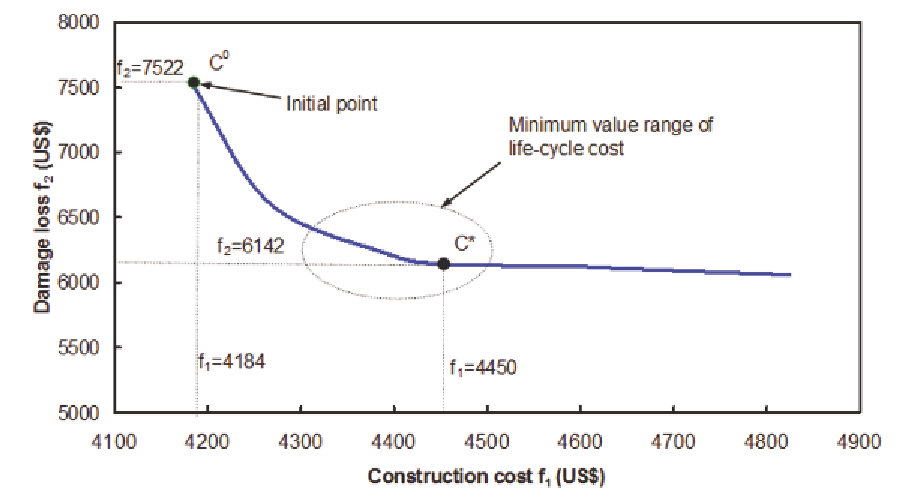Geology Reference
In-Depth Information
the design return period of 50 years. This building
frame is assumed to be a Class B building in this
example and the coefficients of expected failure
loss are shown in Table 1. Other conditions stay
the same as Case B.
Figure 9 presents a Pareto optimal set, which
provides the best compromise between the initial
structure cost,
f
1
, and the damage loss,
f
2
. The
minimum structure cost,
f
1
, for the single objec-
tive optimal design problem given in Eqs. (36)-
(39), i.e., corresponds to Point C0 in Figure 8
where
f
1
=
US
$4184
and the corresponding dam-
age loss,
f
2
, is found to be
US
$7522
. The optimal
steel reinforcement ratios corresponding to Point
C0 are taken as initial steel ratios of members in
the subsequent multi-objective inelastic design
optimization (see Eqs. (33)-(35)) and the optimal
Pareto set curve can then be generated. Besides,
US
$4184
at Point C0 is the minimum value of
the initial structure cost,
f
1
, satisfying design
constraints at this Pareto curve; correspondingly,
US
$7522
at Point C0 is the maximum value of
the damage loss,
f
2
.
Firstly, it is observed from Figure 9 that an
improvement in the damage loss leads to an in-
crease in the initial material cost of the structure.
From the Pareto optimal set, a designer can have
an overview of the tradeoffs. Secondly, any point
in the Pareto optimal set can be selected as an
optimum design, which represents a designer's
preference. A designer has many choices rather
than only one and he/she may finally choose a
particular solution, which he/she thinks, should
be realized. Thirdly, the life-cycle cost can be
further written as
F
1 1 2 2
, where
ϕ
1
and
ϕ
2
are the weighting factors and their magnitudes
are dependent on a designer's decision. A preferred
balance of the initial and damage losses can
therefore be obtained. It is worth noting that dif-
ferent values of
ϕ
1
and
ϕ
2
will lead to different
minimum values of the life-cycle cost.
Figure 6 lists the optimal steel reinforcement
ratios at Points C
0
and C*, respectively. The steel
=
ϕ
f
+
ϕ
f
Figure 9. A Pareto optimal set of Case C

Search WWH ::

Custom Search